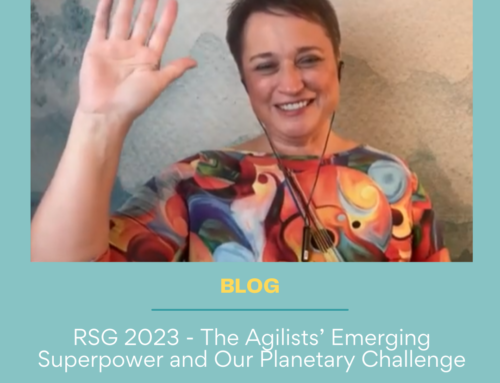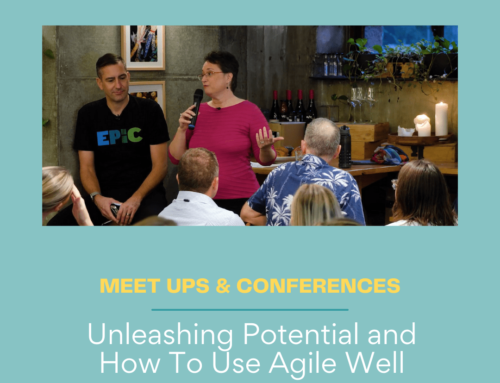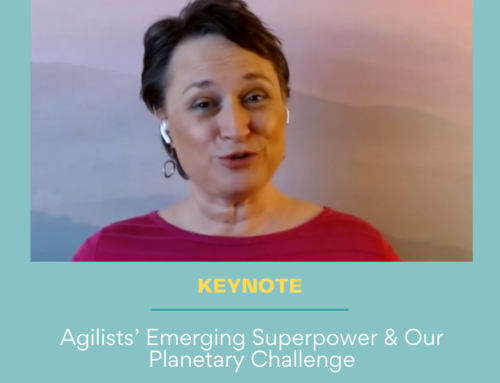
I have enjoyed getting to know Em Campbell-Pretty and her writings on agile. She has a ton of fun and insightful things to say at Adventures in Scaling Agile. Several of them are linked in this post. Here’s Em…
Leading through Vulnerability
When +Jean Tabaka ran her Scaling Collaboration workshop with my team in June, she commented on how open the team was to the experience and asked us how we went about creating an environment where traditionally introverted software engineers, from a diverse range of cultures and backgrounds, were so willing to participate in team activities. From my perspective there were lots of contributing factors eg. the Hakas, Bubble Ups, lean coffee management meetings etc. but it all began with the weekly practise of “walk the walls”.
“Walk the walls” came about after I got sick of listening to my coach, +Mark Richards, carry on about what a waste of time my program status meetings were. At this time, I worked in “the business” and as program sponsor I felt it was my duty to sit down with the program manager once a week to receive an update on the status of the program. Mark, on the other hand, was convinced that there was a deeply embedded culture of fear that was preventing the delivery teams from telling the real story. He was adamant if I spent more time with the teams I would be able to see this for myself.
I remember being mildly insulted by the insinuation that my relationships with the teams weren’t strong enough for them to feel comfortable enough to tell me about their challenges, but eventually I got over myself and blocked out some time in my calendar to visit the them. Even though I was not bombarded with new information in my first visit, with some “gentle” nagging from Mark, I made “walk the walls” a reoccurring appointment in my calendar.
Eventually I built rapport with the teams. They started to give me problems to solve for them, and it was my role to earn their trust by actioning blockers. Later Mark would tell me that part of his motivation in getting me to walk the walls, was to help the team see I was “human”, he said, “I want them to see the Em I see, when we are hanging out debating the issues in your office. “
While “walk the walls” marked the beginning of our cultural change journey for me, in Mark’s view, the beginning was actually about 6 months later, when we launched the EDW Agile Release Train. In our first PSI-Lite / iteration kick off event (aka Unity Day) Mark decided to introduce my new team to The Ball Point Game. Armed with about 100 tennis balls, he split us all up into groups and ran the activity,much to everyone’s delight, hand eye coordination is not one of my strengths, so I spent most of the game dropping tennis balls, laughing nervously and turning very red. I think it would be fair to say I was most embarrassed.
Obviously, Mark thought the activity went well as next sprint he decided to run another activity with the team. This time he asked everyone with manager in their title to go to one corner of the room and pair up and appoint one person as the manager and the other as the worker. Everyone else was to stand between the managers and the opposite conner of the room, creating a maze we would need to navigate our way through. I paired with one of the scrum masters and we agree he would play manager. I don’t think I will ever forget the painful process of being directed through the maze by my manager/scrum master – forward, backwards, stop, left, right. It was not long before all the other pairs had completed the task and there were just shy of 100 people laughing at me trying to complete the maze. Yet another horribly embarrassing morning for me, much to Mark’s delight.
Some time later that Mark told me “embarrassing Em” was all part of his evil plan. Mark knew that vulnerability was the foundation of trust and trust was the foundation of great teams. While I may have been “duped” into showing vulnerability, I learnt a very powerful lesson.
These days, vulnerability is something I am trying to foster right across my team. Just last week, some of my team were on facilitation training and the question of what good facilitation looks like was tabled. One of the working groups, suggested a good facilitator creates safety, which lead to a discussion on how to go about creating safety. In response to this question, I found myself channelling Mark and talking to the team about the power of vulnerability. I reminded them of how the Hakas and other Unity Day antics have brought the team closer together and explained that part of my motivation in inviting our stakeholders to participate in Unity Day was to begin the process of building trust through transparency and vulnerability.
While I know our culture isn’t perfect, I am immensely proud of my team and their willingness to to be vulnerable in front of each other and our colleagues from across the organisation. No matter where it started – “walking the walls” or “agile learning activities” – the openness of all members of the EDW Release Train makes it a truly special place to work.
As agile leaders, we ask our teams to be transparent and consequentially vulnerable every day. We expect this of them, but what do we expect from ourselves? As I contemplate this, I am reminded of a +Brene Brown quote I saw recently:
The vulnerability paradox: It’s the first thing I look for in you and the last thing I want you to see in me.
Our teams want to trust us, they are looking for vulnerability, proof we are human. It is incumbent on us as leaders to take the first step, show our vulnerability to our teams and give them the safety to reciprocate. I may not have recognised it as what I was doing at the time, but looking back I can certainly see the power of it and the need for us to challenge ourselves as leaders to inspire vulnerability by example.
This post originally appeared as Leading Through Vulnerability in July 2013. Thanks, Em, for contributing it!






